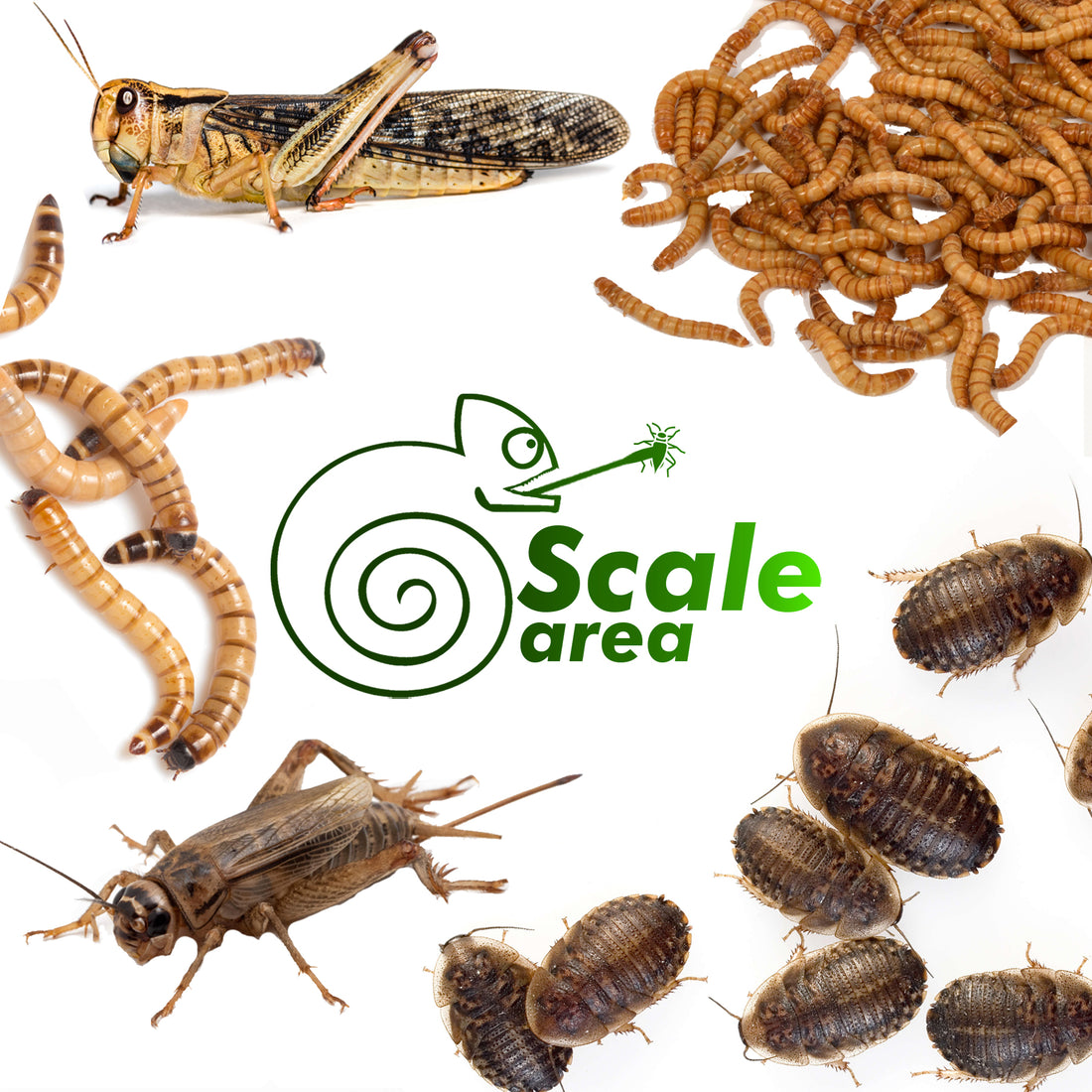- Introduction: Types of food for reptiles, amphibians and insectivorous invertebrates.
In the animal world, reptiles can be herbivores, carnivores, omnivores and insectivores. In this article, we will delve into the universe of live food for insectivorous reptiles in captivity, although the information is also valid for birds and amphibians that consume this type of food. Why settle for the ordinary when you can offer your scaly friends a varied and bouncy diet?

We will discover together why live food is essential for the health and well-being of your reptiles at home. From jumping crickets to irresistible worms, we'll explore the most delicious and nutritious options you can incorporate into your terrarium friends' diet.
Get ready to learn about sizes, species, and specific care for each type of live food. Plus, we'll provide you with practical tips to make feeding a fun experience for both you and your reptiles.
Are you ready to transform mealtime into an exciting feast? Join us on this journey and discover how to make your reptiles' diet as vibrant as they are. Let's dive into the fascinating world of live food for reptiles!
- Why live food is vital for reptiles in captivity.
In the world of captive reptiles, food plays a crucial role in their health and well-being. Unlike more common animals such as dogs and cats, many reptiles and amphibians are insectivores, so they do not feed on feed. In these types of animals, live food is essential for their diet due to several reasons.

- Instinctive stimulation, prevents boredom: Hunting is inherent in the nature of many reptiles, and live food provides the perfect opportunity for them to express these natural behaviors. Allow your pets to be involved in the search and capture process, which is not only natural and exciting for them, but also beneficial for their mental well-being. By providing a varied diet, you prevent your reptiles from falling into dietary monotony. This not only makes meals more exciting, but it also helps prevent boredom problems, which can lead to unwanted behaviors or even health problems.
- Quality Nutrients: Live insects are rich in nutrients, especially if they have been well fed previously. Crickets, roaches, worms and other types of live food provide high-quality proteins, fats and a variety of vitamins and minerals necessary for the growth and overall health of your reptiles.
- Improved natural behavior and physical activity: The introduction of live food not only meets nutritional needs, but can also improve the behavior of your reptiles. Active hunting and eating live prey can stimulate interest and physical activity, contributing to a more active and healthy lifestyle.
In short, live food is essential to recreate an environment closer to nature for your captive reptiles. Offering them a diet that resonates with their natural instincts not only improves their physical health, but also contributes to a fuller and more active life. Keep exploring to find out which live food options are best for your scaly friends!
- Practical Tips for Feeding Your Reptiles Live Food.

- Do not take live food from the field. Many people, especially if they have only one or two reptiles, think about collecting insects directly from nature, but this should not be done since they could be contaminated with pesticides, fertilizers or contain bacteria and parasites that are harmful to the health of our pets. It is best to buy them in specialized stores that take care of the hygiene, nutrition and quality of insects, such as the online store https://www.scalearea.com/collections/alimento-vivo .
- Variety in the Diet. Introduce a wide variety of insects into your reptiles' diet to ensure balanced nutrition. Combine crickets, cockroaches, locusts and other insects to offer a diverse and nutritious dining experience. Later I will explain to you which type of live food is ideal for a daily base diet and which are not.
- Proper Size of Insects. Adjust the size of the insects to the size and species of your reptile. Not providing insects that are too large or small ensures safe and effective feeding.
- Nutritional Enrichment. Before offering insects as food, it is very important that they are well fed with quality feed and vegetables, since they will then pass those nutrients on to our reptiles. An unfed insect is a simple chitin exoskeleton with no nutritional value. It is also important to use calcium and vitamin supplements a few days a week to compensate for possible deficiencies and maintain the necessary nutritional balance. We will expand this information in another different article dedicated to dietary supplements.
- Frequency and Time of Feeding. Establish a feeding schedule to maintain a consistent rhythm, knowing if the animal is diurnal or nocturnal. Feeding frequency varies depending on the species and life stage of the reptile, so learn about specific needs.
- Active Observation. Observe your reptiles whenever possible during feeding to ensure that they consume insects and to detect any unusual behavior. This will allow you to adjust the diet according to the individual preferences of each reptile.
- Terrarium Hygiene. Remove uneaten insects after each feeding session to avoid hygiene problems in the terrarium and possible insect damage to your pet, especially crickets have powerful jaws that can harm your reptile while it sleeps. This helps maintain a clean and healthy environment for your reptiles.
By following these practical tips, you will be able to provide your reptiles with a varied and nutritious diet that will contribute to their well-being and vitality in captivity.
- Types of live food
In the captivating world of reptile feeding, the diversity and quality of live food plays a critical role in the health and well-being of these fascinating creatures. As we explore various types of live insects, we will dive into their sizes, nutritional profiles, and the importance of maintaining a proper balance of calcium and phosphorus in your reptiles' diet, and we will also explain their basic care.
Cricket Acheta domesticus or Assimilis.
https://www.scalearea.com/collections/grillos-1

- Size: Variable, from a few millimeters (microcricket) to more than two centimeters.
- Nutrients: The cricket is one of the most used insects for feeding reptiles since it has a nutritional value high in protein and low in fat, ideal for the base diet of any insectivorous species.
- Maintenance: Easy to keep at home in a tall plastic container without a lid or with plenty of ventilation, they require a suitable substrate (wheat bran), controlled temperature between 20 and 28 degrees, a food source (vegetable protein feed and vegetables) and a source of hydration (vegetable, wet cotton or water gel).
Blaptica dubia cockroach:
https://www.scalearea.com/collections/grillos

- Size: From 0.5cm to more than 3cm.
- Nutrients: It is an ideal cockroach as a base diet, because it has a high protein content, low amount of fat and a good Ca:P (Calcium/Phosphorus) ratio.
- Maintenance: Resistant and easy to raise, they need a preferably dark environment with ventilation, they require an adequate substrate (wheat bran), controlled temperature between 20 and 28 degrees, a food source (vegetable protein feed and vegetables) and a source of hydration (vegetable, wet cotton or water gel). It is one of the best species to use as live food since they are not able to climb smooth surfaces so it is difficult for them to escape from a feeder.
Locust (Locusta migratoria):
https://www.scalearea.com/collections/langostas

- Size: Variable, from a few millimeters to more than 3 centimeters.
- Nutrients: They are an ideal food for all types of reptiles that can be used as a base diet, due to a balanced balance of protein and fat. It is one of the favorite foods for many reptiles.
- Maintenance: Their maintenance in captivity is more complicated because they need fresh vegetables and high temperatures, so it is recommended to use them first when receiving an order for live food, at room temperature they last several days in good condition.
Tenebrio molitor or Mealworm:
https://www.scalearea.com/collections/gusanos

- Size: About 2-3 centimeters.
- Nutrients: Larva suitable for all types of reptiles, from newborns to larger ones. Due to its high fat content, it is not advisable as a base diet, rather use it as a treat or for those reptiles that have a lack of appetite, since most of them cannot resist trying them. It is also ideal for feeding those reptiles that need an extra supply of fat or for those that are going to enter or have just come out of hibernation.
- Maintenance: Easy to maintain, they need an abundant substrate of wheat bran and you can give them vegetables or peelings of this for hydration, they will last long periods of time before turning into pupae and beetles, so you will have time to use them up if you buy the amount you need.
Zophoba morio or King Worm:
https://www.scalearea.com/collections/gusanos

- Size: Approximately 4 centimeters.
- Nutrients: Larva larger than the tenebrium. Due to its high fat content, it is not advisable as a base diet, rather use it as a treat or for those reptiles that have a lack of appetite, since most of them cannot resist trying them. It is also ideal for feeding those reptiles that need an extra supply of fat or for those that are going to enter or have just come out of hibernation.
- Maintenance: Same as tenebrio, but require more hydration.
Honeyworm (approx. 2cm):
https://www.scalearea.com/collections/gusanos

- Size: About 2 centimeters.
- Nutrients: It contains a lot of fat so it is not recommended to abuse them.
- Maintenance: They are somewhat more difficult to maintain, so it is recommended to store them in the refrigerator so that they last a few weeks.
Phoenix worm (Hermetia illucens):
https://www.scalearea.com/collections/gusanos

- Size: Variable, up to 2 centimeters.
- Nutrients: The Phoenix worm is one of the most complete worms in terms of nutrition, this is because it has a high quality protein and low amount of fat, a very balanced balance of calcium phosphorus, large amounts of lauric acid, a compound with powerful antimicrobial properties, which helps strengthen the immune system of our pets, they do not bite, they do not have legs and it is difficult for them to climb to escape from the feeder.
- Maintenance: In the refrigerator its development is slower, when the larva becomes black it is the last phase before becoming the well-known soldier fly and in this black state is when they concentrate the greatest amount of calcium.
Isopods or scale insects: https://www.scalearea.com/collections/isopodos .

- Size: Varies depending on the species, from a few millimeters to several centimeters.
- Nutrients: High nutritional value, great contribution of minerals, especially calcium.
- Maintenance: all the information is in this article: https://www.scalearea.com/blogs/noticias/mantenimiento-y-reproduccion-de-isopodos-terrestres-en-cautividad .
Drosophila: https://www.scalearea.com/collections/micro-alimento .

- Size: Very small, around 1-3 millimeters.
- Nutrients: Low in fat, but rich in other beneficial substances, ideal for small animals.
- Maintenance: They can be raised easily, they require a growing medium and warm temperatures. Later we will make an article on how to grow them.
Springtail: https://www.scalearea.com/collections/micro-alimento .

- Size: Very very small, about 0.2-1 millimeters.
- Nutrients: High nutritional value for small pets.
- Maintenance: They can be raised easily, they require a very humid substrate, food that cannot be decomposed and warm temperatures.
These different types of live food provide an exciting opportunity to enrich your reptiles' diet, but it is essential to understand their characteristics and how to maintain them to ensure optimal nutrition. The key lies in variety and enrichment, making sure to provide your flaky friends with a balanced diet that closely mimics their natural eating habits.
Remember that you can order live, fresh, quality food at the best price on our website https://www.scalearea.com/collections/alimento-vivo .

